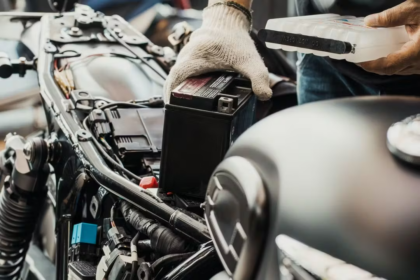
Motorcyclists know that keeping your bike in top shape goes beyond regular maintenance; it includes ensuring your battery functions properly.
A well-maintained battery is crucial for performance, longevity, and, most importantly, getting you back on the road. Below we’ll go over:
- how often you should ride your motorcycle to charge the battery
- signs it might be time for a replacement
- what can ruin a motorcycle battery
- the best types of batteries for your ride
- how to get the most out of your battery for the long-term
This month, we’re offering FREE Batteries for Life! Grab this deal >
How Often Should You Ride Your Motorcycle?
If you want to keep your battery charged and in good health, regular riding is key.
Short trips—less than 15 or 20 miles—often aren’t enough for your motorcycle’s charging system to effectively recharge the battery.
If you’re only using your bike a couple of times per week, you might find yourself with a low state of charge, which can make starting your engine a challenge. To keep your battery in prime condition, aim for longer rides that allow the charging system to work efficiently.
7 Signs You Need to Replace Your Motorcycle Battery
Even with the best care, batteries don’t last forever. Here are seven signs that indicate it might be time for a replacement:
- Built-up Sulfation: This occurs when a battery sits too long without being charged.
- Longer Start Times: If your motorcycle is taking longer to start, your battery may be losing its charge.
- Corroded Terminals: Badly corroded terminals can impede electrical flow.
- Weak Horn and Dimming Headlights: If your bike’s electrical components are showing signs of weakness, it could be a battery issue.
- Leaking Acid: Any visible leaks are a clear sign the battery is failing.
- Age: Most batteries last between two to five years, depending on the type.
- Erratic Multi-meter Readings: If your readings are inconsistent, it’s time to investigate further.
Choosing the Right Battery for Your Motorcycle
Many motorcycle owners wonder: Can I put a more powerful battery in my motorcycle?
The answer is yes!
Motorcycles can run on various battery types, including:
- traditional flooded batteries
- absorbent glass mat (AGM) batteries
- high-performance lithium batteries
Benefits of Lithium Batteries
Lithium batteries are particularly appealing due to their longevity—up to four times longer than traditional batteries—and their rapid charging capabilities. They also weigh about 55% less than lead-acid batteries and have very low self-discharge rates, which means they can hold a charge much longer when in storage.
What Can RUIN a Motorcycle Battery?
Several external factors can negatively impact your motorcycle battery’s lifespan:
- Humidity: High moisture levels can promote terminal corrosion.
- Exposure to Elements: Rain, snow, and debris can lead to premature battery failure.
- Heat and Vibration: Both are detrimental to battery health, causing internal damage that may not be immediately apparent.
This month, we’re offering FREE Batteries for Life! Grab this deal >
How Long Should Your Motorcycle Battery Last?
Typically, a sealed Absorbed Glass Mat (AGM) battery will last about three to five years, while a conventional acid-filled battery may last between two to five years. If you get four or five years out of your battery, you’ve done well!
Make it a habit to ride your bike regularly, keep an eye out for warning signs, and choose the right battery type to maximize your motorcycle’s performance. With the right care and attention, you can ensure your bike is always ready to hit the road.
What Can I Do To Get The Most Out of My Battery?
To get the most out of your motorcycle’s battery, regular maintenance is key. One of the best ways to ensure your battery stays in top condition is by using a motorcycle battery tender.
-
Use a Battery Tender:
If your motorcycle sits more than a day or two without riding, you can start to lose a charge and do long-term damage to your battery. The number one thing you can do when your motorcycle is parked is plug in a battery tender or trickle charger. A battery tender helps to prevent the battery from draining or deteriorating over time.
Whether you’re storing your bike during the off-season or simply want to extend the life of your current battery, a bike battery tender is an easy, cost-effective solution that can save you from unexpected power issues. This will also help ensure your bike starts every time and extend the overall life of your battery.
-
Routine Maintenance:
Be sure to check your battery terminal tightness at least once a year or every 5,000 miles, whichever occurs first. A loose battery terminal can short out a battery in a matter of minutes. Load test your battery at least once a year. Most battery failures are gradual and catching a weak battery before an outright failure can save you from ending up on the side of the road.
-
Accessorize Wisely:
Additional electronic accessories such as radios, amplifiers, GPS, and lighting can put extra strain on your battery and charging system. Limiting your electrical add-ons will extend your battery life. Another battery killer is running accessories such as radios and accent lighting when the motorcycle is not running.
This month, we’re offering FREE Batteries for Life! Grab this deal >
By incorporating these practices, you can keep your motorcycle battery healthy and extend its lifespan, ensuring your adventures on two wheels are always electrifying!
So gear up and ride on—your motorcycle and its battery will thank you!
YOU MAY ALSO LIKE:
12 Tips for a Great Fall Ride in the Midwest





